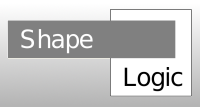
ShapeLogic is made to have as few dependencies as possible. Since it will use template code from Boost it will require a relatively modern C++ compiler.
When building ShapeLogic try to compile the libraries and ShapeLogic with the same version of the same compiler, since linker format can be different between different compiler and version of a compiler.
Microsoft Visual C++ is the compiler that has been used for development of ShapeLogic C++ under Windows.
MS VC++ Express Edition is a free version.
FLTK comes with a MSVC project file. The VC 2005 project file compiled with MS VC++ Express Edition 2008.
Bjam will automatically set the toolset to msvc, so it is not necessary to have a user-config.jam file in the home directory.
There are 2 ways to run GCC under Windows CygWin and MinGW.
Is a Linux emulation under windows, translating system calls. All program made Cygwin with will have to be GPL.
MinGW is a collection of programs, libraries and utilities. Compiles directly to Windows and will be a better solution for most people.
Nuwen's MinGW distribution contains the newest version GCC and other libraries: GCC 4.2.1 and Boost 1.36. This is an easy way to get started.
FLTK comes with a Makefile and should compile using MinGW. In order to get the Makefile to work you also need to install MSYS, which is a minimalistic shell. This is not trivial to get to work.
Here are the general installation instruction.
Under Ubuntu you can install it using Synaptic.
Currently all the libraries that are used are based only on include files.
Boost Build is a cross platform Make replacement.
Using Boost Build / Bjam is very simple, at command line just type
bjam bjam <target name>
This will both build executables, libraries, run unit test, create distributions.
The Jamfile and Jamroot are documented and it should be easy to modify them to fit your needs.
As of ShapeLogic C++ 0.4 the same Jamfile and Jamroot is be used for Windows and other operating systems. If you are trying to build an earlier version there are a Jamfile.msvc and a Jamroot.msvc. In order to build rename them to Jamfile and Jamroot.
Currently it is assumed that some of the libraries are located relative to the shapelogic-cpp directory in a directory called src. The relative path from shapelogic-cpp to boost would then be:
../src/boost_1_36_0/
This may change.
Eclipse works well under UNIX, but for Windows development using Microsoft Visual C++, might be better.